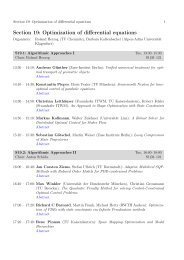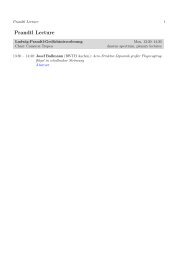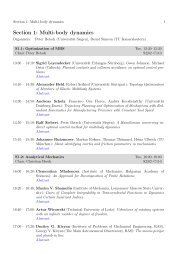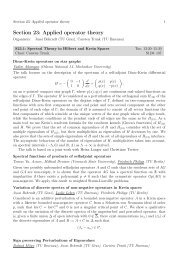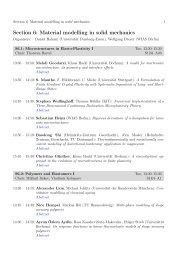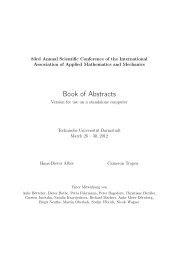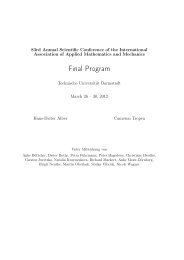Section 6: Material modelling in solid mechanics - GAMM 2012
Section 6: Material modelling in solid mechanics - GAMM 2012
Section 6: Material modelling in solid mechanics - GAMM 2012
Create successful ePaper yourself
Turn your PDF publications into a flip-book with our unique Google optimized e-Paper software.
22 <strong>Section</strong> 6: <strong>Material</strong> <strong>modell<strong>in</strong>g</strong> <strong>in</strong> <strong>solid</strong> <strong>mechanics</strong><br />
[3] Marckmann G, Verron E (2006), Comparison of hyperelastic models for rubber-like materials.<br />
Rubber Chemistry and Technology, 79 (2006) 835-858<br />
Accelerat<strong>in</strong>g constitutive model<strong>in</strong>g by automatic tangent generation<br />
Steffen Rothe, Stefan Hartmann (TU Clausthal)<br />
Nowadays models become more and more complex. With<strong>in</strong> the framework of f<strong>in</strong>ite elements a<br />
material, i.e. consistent, tangent is required for the overall Newton-like method. Obta<strong>in</strong><strong>in</strong>g these<br />
derivatives is time consum<strong>in</strong>g and error-prone which contradicts to the goal of chang<strong>in</strong>g the model<br />
dur<strong>in</strong>g the develop<strong>in</strong>g process. On the one hand the calculation by hand can be very expensive<br />
and on the other hand also the implementation has to be done with high diligence. Therefore, a<br />
fast and safe way of consistent tangent generation will be presented with the help of automatic<br />
differentiation (AD) techniques.<br />
Analytical tangents have the advantage that they are exact. However dur<strong>in</strong>g the constitutive<br />
model<strong>in</strong>g process a change of the model is natural. Thus, the effort is very high to calculate<br />
the derivative after every modification. Numerical tangents computed by f<strong>in</strong>ite differences are<br />
easy to compute, but can lead to a significant slowdown or even to a failure of the simulation<br />
due to numerical errors. Tangents generated by OpenAD have no round-off errors and are easily<br />
computed by the help of automatic differentiation.<br />
These three methods (analytical, numerical and automatic differentiation) for tangent generation<br />
will be analyzed concern<strong>in</strong>g the simulation time and applicability for a number of different<br />
constitutive models.<br />
S6.9: Microheterogeneous <strong>Material</strong>s Thu, 13:30–15:30<br />
Chair: Johannes Schnepp, Eleni Agiasofitou S1|01–A03<br />
The boundary value problems of the full coupled theory of poroelasticity for materials<br />
with double porosity<br />
Merab Svanadze (Ilia State University, Tbilisi)<br />
Porous materials play an important role <strong>in</strong> many branches of eng<strong>in</strong>eer<strong>in</strong>g, e.g., the petroleum <strong>in</strong>dustry,<br />
chemical eng<strong>in</strong>eer<strong>in</strong>g, geo<strong>mechanics</strong>, and, <strong>in</strong> recent years, bio<strong>mechanics</strong>. The construction<br />
and the <strong>in</strong>tensive <strong>in</strong>vestigation of the theories of cont<strong>in</strong>ua with microstructures arise by the wide<br />
use of porous materials <strong>in</strong>to eng<strong>in</strong>eer<strong>in</strong>g and technology.<br />
The general 3D theory of poroelasticity for materials with s<strong>in</strong>gle porosity was formulated by<br />
Biot (1941). The double porosity model was first proposed by Barenblatt and coauthors (1960).<br />
The quasi-static theory of poroelasticity for materials with double porosity <strong>in</strong> the framework of<br />
mixture theory was presented by Aifantis and his co-workers (1982).<br />
In this paper the full coupled theory of poroelasticity for materials with double porosity is<br />
presented. This theory unifies the earlier proposed quasi-static model of Aifantis of con<strong>solid</strong>ation<br />
with double porosity. The boundary value problems (BVPs) of the steady vibrations are <strong>in</strong>vestigated.<br />
The fundamental solution of system of equations of steady vibrations is constructed. The<br />
basic properties of plane waves and the radiation conditions for regular vector are established. The<br />
uniqueness theorems of the <strong>in</strong>ternal and external BVPs of steady vibrations are proved. The basic<br />
properties of elastopotentials are established. The representation of general solution of equations<br />
of steady vibrations is obta<strong>in</strong>ed. The existence of regular solution of the BVPs by means of the<br />
boundary <strong>in</strong>tegral method and the theory of s<strong>in</strong>gular <strong>in</strong>tegral equations are proved.



